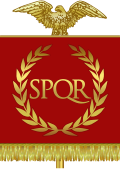
Back Rōmānisc Cāsere ANG إمبراطور روماني Arabic Emperador romanu AST Roma imperatoru Azerbaijani Romanong Emperador BCL রোমের সম্রাট Bengali/Bangla Emperador romà Catalan Emperador sa Roma CEB Římský císař Czech Kejser (Rom) Danish
| Emperor of the Roman Empire | |
|---|---|
Imperial | |
 Vexillum of the emperor | |
 Bust of Augustus wearing the corona civica | |
| Details | |
| Style | Imperator, Caesar, Augustus, Princeps, Dominus Noster, Autokrator or Basileus (depending on period) |
| First monarch | Augustus |
| Last monarch | |
| Formation | 16 January 27 BC |
| Abolition |
|
| Appointer | Senate (official), Roman military |
The Roman emperor was the ruler and monarchical head of state of the Roman Empire, starting with the granting of the title augustus to Octavian in 27 BC.[2] The term emperor is a modern convention, and did not exist as such during the Empire. When a given Roman is described as becoming emperor in English, it generally reflects his accession as augustus, and later as basileus. Another title used was imperator, originally a military honorific, and caesar, originally a cognomen. Early emperors also used the title princeps ('first one') alongside other Republican titles, notably consul and pontifex maximus.
The legitimacy of an emperor's rule depended on his control of the Roman army and recognition by the Senate; an emperor would normally be proclaimed by his troops, or by the Senate, or both. The first emperors reigned alone; later emperors would sometimes rule with co-emperors to secure the succession or to divide the administration of the empire between them. The office of emperor was thought to be distinct from that of a rex ('king'). Augustus, the first emperor, resolutely refused recognition as a monarch.[3] For the first three hundred years of Roman emperors, efforts were made to portray the emperors as leaders of the Republic, fearing any association with the kings who ruled Rome prior to the Republic.
From Diocletian, whose reformed tetrarchy divided the position into one emperor in the West and one in the East, emperors ruled in an openly monarchic style.[4] Although succession was generally hereditary, it was only hereditary if there was a suitable candidate acceptable to the army and the bureaucracy,[5] so the principle of automatic inheritance was not adopted, which often led to several claimants to the throne. Despite this, elements of the republican institutional framework (Senate, consuls, and magistrates) were preserved even after the end of the Western Empire.
Constantine the Great, the first Christian emperor, moved the capital from Rome to Constantinople, formerly known as Byzantium, in 330 AD. Roman emperors had always held high religious offices; under Constantine there arose the specifically Christian idea that the emperor was God's chosen ruler on earth, a special protector and leader of the Christian Church, a position later termed Caesaropapism. In practice, an emperor's authority on Church matters was frequently subject to challenge. The Western Roman Empire collapsed in the late 5th century after multiple invasions by Germanic barbarian tribes, with no recognised claimant to Emperor of the West remaining after the death of Julius Nepos in 480. Instead the Eastern emperor Zeno proclaimed himself as the sole emperor of a theoretically undivided Roman Empire (although in practice he had no authority in the West). The subsequent Eastern emperors ruling from Constantinople styled themselves as "Basileus of the Romans" (Ancient Greek: βασιλεύς Ῥωμαίων, Basileus Romaíon) but are often referred to in modern scholarship as Byzantine emperors.
The papacy and Germanic kingdoms of the West acknowledged the Eastern emperors until the accession of Empress Irene in 797. After this, the papacy created a rival lineage of Roman emperors in western Europe, the Holy Roman Emperors, which ruled the Holy Roman Empire for most of the period between 800 and 1806. These emperors were never recognized in Constantinople and their coronations resulted in the medieval problem of two emperors. The last Eastern emperor was Constantine XI Palaiologos, who died during the Fall of Constantinople to the Ottoman Empire in 1453. After conquering the city, Ottoman sultans adopted the title "Caesar of the Romans" (kayser-i Rûm). A Byzantine group of claimant emperors existed in the Empire of Trebizond until its conquest by the Ottomans in 1461, although they had used a modified title since 1282.
- ^ Bury 2012, p. 408.
- ^ Watkin 2017, p. 37.
- ^ Galinsky 2005, pp. 13–14.
- ^ Williams 1997, p. 147.
- ^ Heather 2005, p. 28.
Cite error: There are <ref group=lower-alpha> tags or {{efn}} templates on this page, but the references will not show without a {{reflist|group=lower-alpha}} template or {{notelist}} template (see the help page).